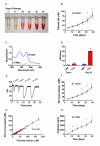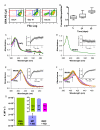Nitric oxide scavenging by red blood cell microparticles and cell-free hemoglobin as a mechanism for the red cell storage lesion
- PMID: 21747051
- PMCID: PMC3891836
- DOI: 10.1161/CIRCULATIONAHA.110.008698
Nitric oxide scavenging by red blood cell microparticles and cell-free hemoglobin as a mechanism for the red cell storage lesion
Abstract
Background: Intravascular red cell hemolysis impairs nitric oxide (NO)-redox homeostasis, producing endothelial dysfunction, platelet activation, and vasculopathy. Red blood cell storage under standard conditions results in reduced integrity of the erythrocyte membrane, with formation of exocytic microvesicles or microparticles and hemolysis, which we hypothesized could impair vascular function and contribute to the putative storage lesion of banked blood.
Methods and results: We now find that storage of human red blood cells under standard blood banking conditions results in the accumulation of cell-free and microparticle-encapsulated hemoglobin, which, despite 39 days of storage, remains in the reduced ferrous oxyhemoglobin redox state and stoichiometrically reacts with and scavenges the vasodilator NO. Using stopped-flow spectroscopy and laser-triggered NO release from a caged NO compound, we found that both free hemoglobin and microparticles react with NO about 1000 times faster than with intact erythrocytes. In complementary in vivo studies, we show that hemoglobin, even at concentrations below 10 μmol/L (in heme), produces potent vasoconstriction when infused into the rat circulation, whereas controlled infusions of methemoglobin and cyanomethemoglobin, which do not consume NO, have substantially reduced vasoconstrictor effects. Infusion of the plasma from stored human red blood cell units into the rat circulation produces significant vasoconstriction related to the magnitude of storage-related hemolysis.
Conclusions: The results of these studies suggest new mechanisms for endothelial injury and impaired vascular function associated with the most fundamental of storage lesions, hemolysis.
Figures





Comment in
-
Letter by Lin et al regarding article, "Nitric oxide scavenging of red blood cell microparticles and cell-free hemoglobin as a mechanism for the red cell storage lesion".Circulation. 2012 Feb 21;125(7):e384. doi: 10.1161/CIRCULATIONAHA.111.066100. Circulation. 2012. PMID: 22354984 No abstract available.
References
-
- The 2007 National Blood Collection and Utilization Survey Report. US Dept of Health and Human Services; Washington DC: 2009.
-
- Vincent JL, Baron JF, Reinhart K, Gattinoni L, Thijs L, Webb A, Meier-Hellmann A, Nollet G, Peres-Bota D. Anemia and blood transfusion in critically ill patients. JAMA. 2002;288:1499–507. - PubMed
-
- Napolitano LM, Kurek S, Luchette FA, Corwin HL, Barie PS, Tisherman SA, Hebert PC, Anderson GL, Bard MR, Bromberg W, Chiu WC, Cipolle MD, Clancy KD, Diebel L, Hoff WS, Hughes KM, Munshi I, Nayduch D, Sandhu R, Yelon JA. Clinical practice guideline: red blood cell transfusion in adult trauma and critical care. Crit Care Med. 2009;37:3124–57. - PubMed
-
- Corwin HL, Gettinger A, Pearl RG, Fink MP, Levy MM, Abraham E, MacIntyre NR, Shabot MM, Duh MS, Shapiro MJ. The CRIT Study: Anemia and blood transfusion in the critically ill--current clinical practice in the United States. Crit Care Med. 2004;32:39–52. - PubMed
Publication types
MeSH terms
Substances
Grants and funding
LinkOut - more resources
Full Text Sources
Other Literature Sources
Medical
Molecular Biology Databases

